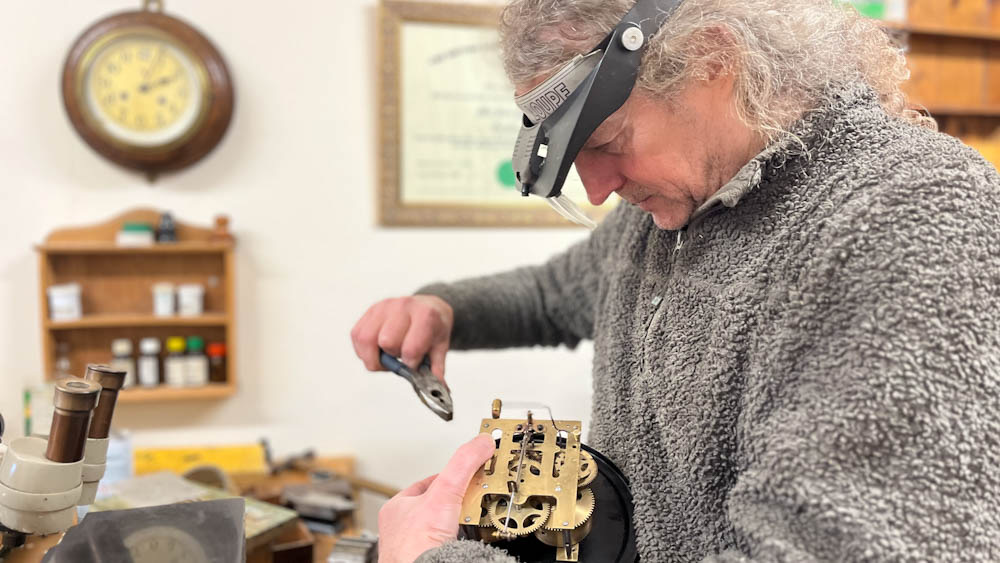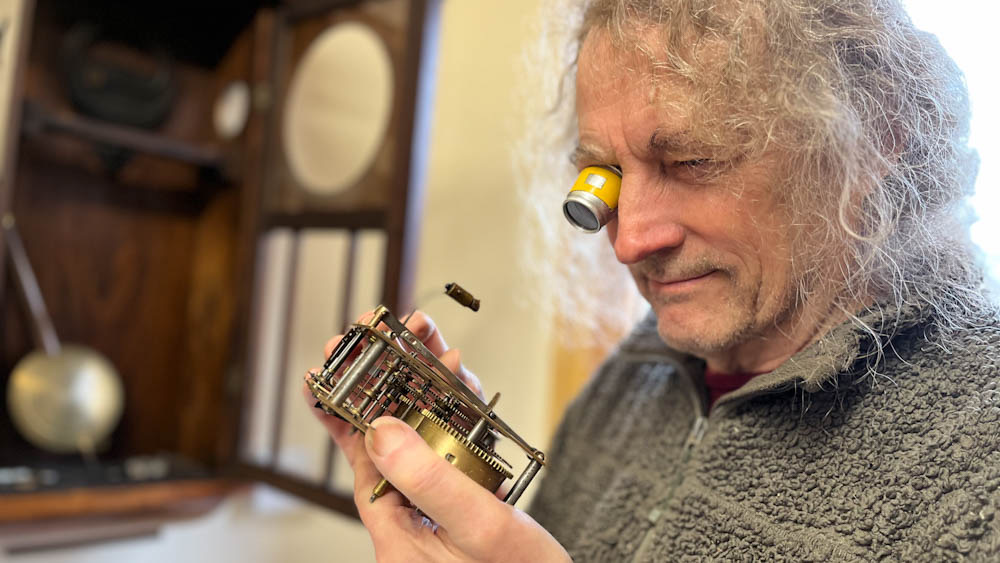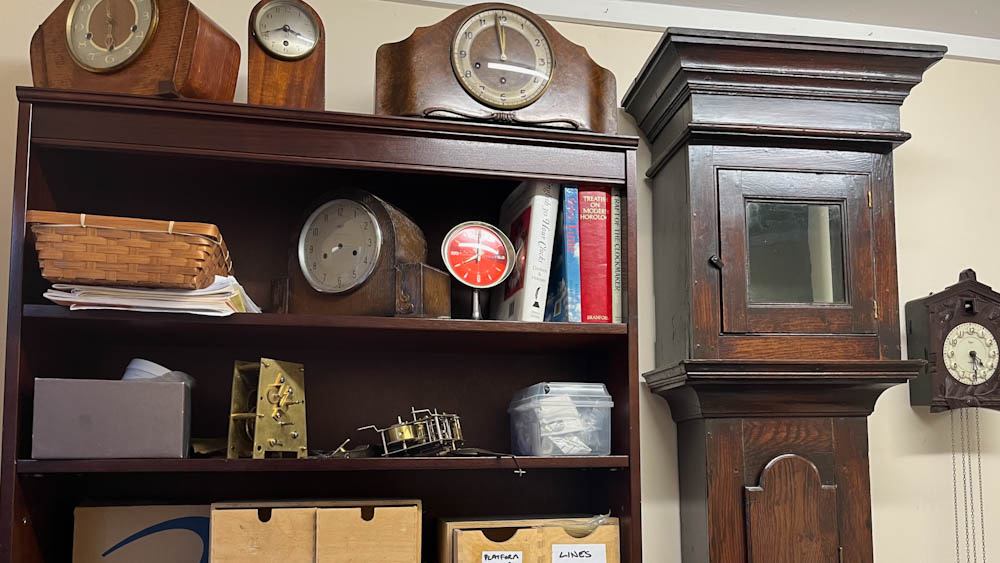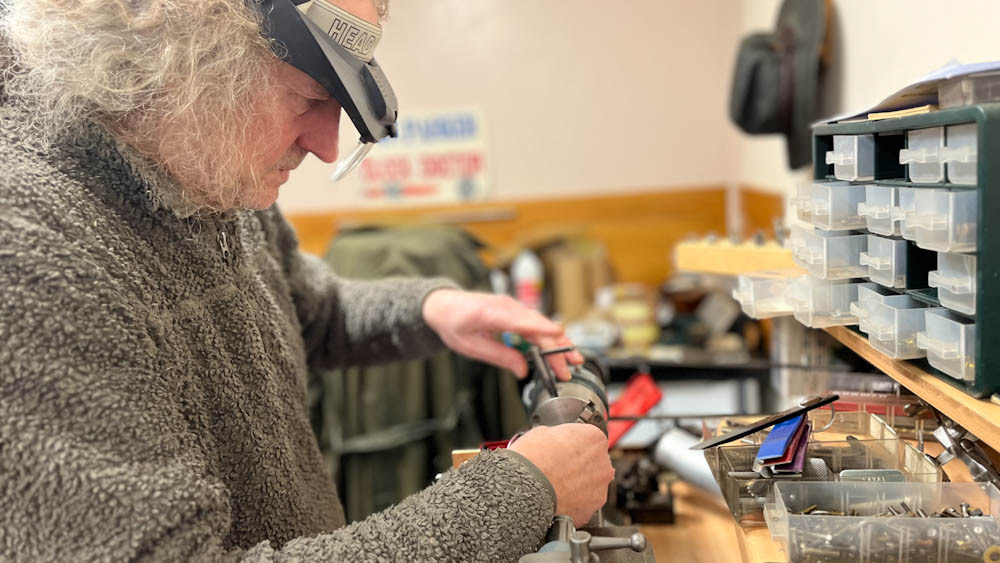In a digital world where everyone has a mobile phone in their pocket fixing clocks and timepieces seems like a profession from another age. But Cardiff horologist Jon Parker is on a mission to keep his craft alive.

Clocks are like mini-universes of precision engineering. Picture a maze of gears, each tooth interlocking with the next, transferring energy and orchestrating movement. Springs coil and uncoil, storing and releasing energy to power the clock’s motion.
And then there’s the pendulum, swinging back and forth with hypnotic rhythm, regulating the passage of time. In the world of clocks, where gears and springs work together to mark time, there’s one person who skillfully brings them back to life.
Inside the railway gardens in Cardiff, Jon Parker operates a clock repair shop where you can watch him mending a clock for a customer, skilfully dismantling the dial, carefully removing the rusty parts with a pair of tweezers, and then opening the treasure chest to look for alternatives.
“My job is more about conservation than repair. I deal with objects of sentimental or historical value. There are many old trades that are in danger of dying out, and clock-making is one of them. So I’m a bit of a dinosaur, I’m keeping an old tradition alive,” Jon said.
He respects the antiquity of each timepiece, preferring to maintain their aged characteristics rather than restoring them to a ‘as new’ condition, which he believes would strip the clocks of their historical essence.
“I’ve got lots of old bits of clocks. It’s like being handed from one person to another. Most of it is just junk. But every now and then, you find the one bit that you need. I use old bits to repair so that it matches and looks as old, it doesn’t look new.”

When he was a little boy, he wanted to be a guitar maker. But when he grew up, he went off to study electronics. He then pursued a career in electronics, which was considered more financially secure and led to a decade-long career with the BBC. However, this path didn’t fulfil him.
The turning point in Jon’s life came unexpectedly, as a birthday present from his mother. Instead of choosing something predictable, Jon found himself drawn to an old, intricate clock in a local market. This seemingly simple purchase was the key that unlocked a door he didn’t realise was closed. As he tinkered with the clock, he rekindled his passion for craftsmanship.
Encouraged by the support of his wife Judi, he made the bold decision to leave the world of electronics behind. He said: “After a while, I decided that I wanted to go back to working with my hands. I’m much enjoying this more than I’m enjoying working in television. I think I want to learn to do this as a career.”
It was not just a career change for him, but a leap of faith into a world where time moves differently, where every tick and tock told a story, and where Jon felt he truly belonged.

Before Jon came to Cardiff, he spent three years studying at the Birmingham School of Jewellery to qualify as a horologist. When he furthered his skills, he was asked to teach Horology at Birmingham City University. During Jon’s clock repairing journey, he rescued a clock case made in West Wales in the early 1800s.
The clock case once belonged to Ellen, she is a woman burdened by the legacy of a clock case handed down through generations. When her grandchildren wanted to burn the case , she turned to Jon for help in finding a sanctuary for this piece of family history.
Jon was immediately drawn to the cause upon hearing Ellen’s story. The clock case was not just an object of time but also a vessel of history, carrying stories from a past that was swiftly being forgotten. Considering the importance of clock conservation, Jon said, “The idea of destroying such a piece was not acceptable.”
Ellen was convinced by Jon’s passion and commitment to saving the clock case. They worked together to develop the idea of putting the piece up for auction, a process that would not only determine its value, but also find it a home where it would be appreciated and preserved. At last, the transaction was settled at the value of 1,000 pounds, even though Jon did not make a lot of money by doing repair work.

But what sets Jon apart from the rest is not just his skill, but his approach to his craft. He measures success not by commercial standards, but by the fulfilment he finds behind each timepiece he restores. “I enjoy the work so much, it kind of feels wrong to charge for it,” he said.
“I’m not really working at a commercial level, I had to repair two clocks just to make ends meet,” he said. “Fortunately, I have regular pensions to fall back on that I bought at an early age, so I can spend on my hobby.”
For Jon, it’s not about the paycheck, but the privilege of being entrusted with family heirlooms, passed down from one generation to the next. “Clocks are more than just timepieces; they’re guardians of memories, passed down through generations,” he said, “I feel happy to be part of that to be able to help people preserve that line.”
“People have given me a clock to repair that belonged to their grandparents, and they’ve known it since they were a little boy or girl, and their grandparents said to them, ‘One day, you will have to look after that clock. I hope you do it properly.’ And they feel that. I enjoy being able to provide that service to people.”

Although Jon has a deep-rooted love for creating and fixing things. There’s a time he accidentally broke a tiny piece of an antique Rolex that his wife Judi had purchased while he was still learning his craft. This mistake resulted in the watch being stored in what Jon jokingly refers to as the ‘drawer of shame’ for approximately 25 years.
Last year, he suddenly felt inspired to take on this old challenge once again. Driven by a mix of inspiration and a quest for closure, he led himself to eBay, where he searched for and found a replacement watch for parts. This discovery allowed him to swap the necessary components and finally get Judi’s watch running again.
Reviving the antique Rolex successfully became Jon’s proudest repair. It was not just a repair job but a personal challenge that connected him back to his student days. He said: “When you encounter an unexpected problem, you’ve got to perform at your very best in order to be able to overcome it.”
Due to technological and societal advancements, the clock repair business is declining and the number of clock repairers is decreasing, but there will always be a few more serious and passionate people who maintain this declining and dying art.
In a world driven by profits, Jon’s workshop stands as a model of tradition and craftsmanship. His fees may be modest, but his passion for clock conservation is boundless. “Restoring them isn’t just about fixing gears, it’s about preserving history and connecting with the stories they hold. And as long as there are clocks to mend and stories to cherish, I’ll be here, weaving the threads of time together,” he said.
